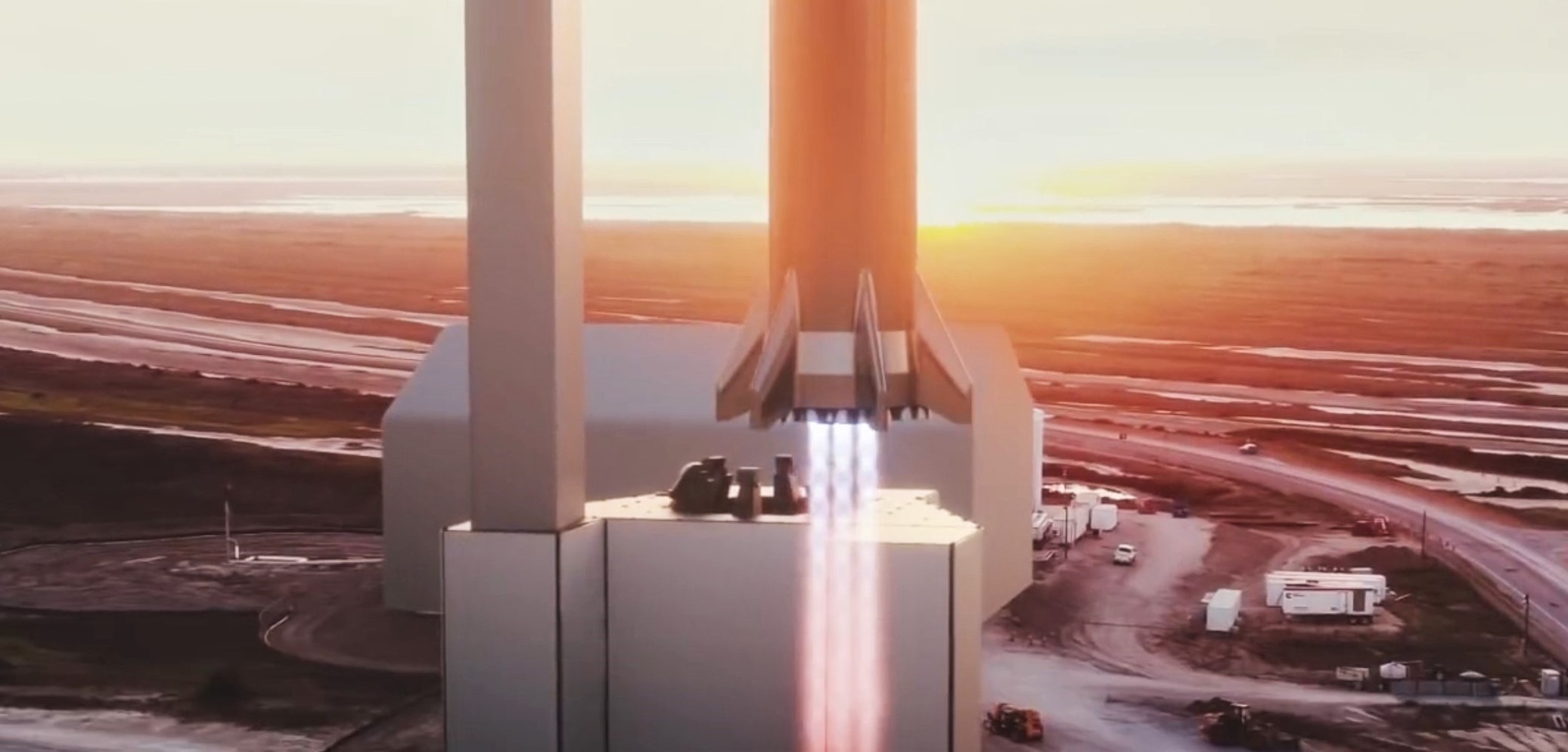
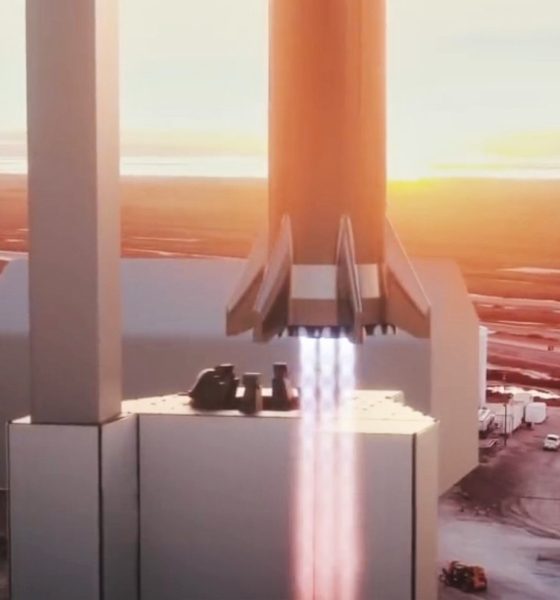
News
SpaceX begins Starship launch mount installation at historic Pad 39A in Florida
At the same time as SpaceX’s Boca Chica, Texas team is working around the clock to prepare Starship Mk1 for several major tests, the company is building a second dedicated Starship launch complex at Pad 39A and as of November 4th, that construction effort has reached a symbolic milestone.
According to photos taken by local resident and famed rocket and ship photographer Julia Bergeron on a bus tour of Kennedy Space Center (KSC), SpaceX has officially begun to install a large steel structure at Launch Complex 39A, a pad the company has leased from NASA since 2014. Known as a launch mount, the massive structure will one day support SpaceX’s first East Coast Starship and Super Heavy static fires and test flights.
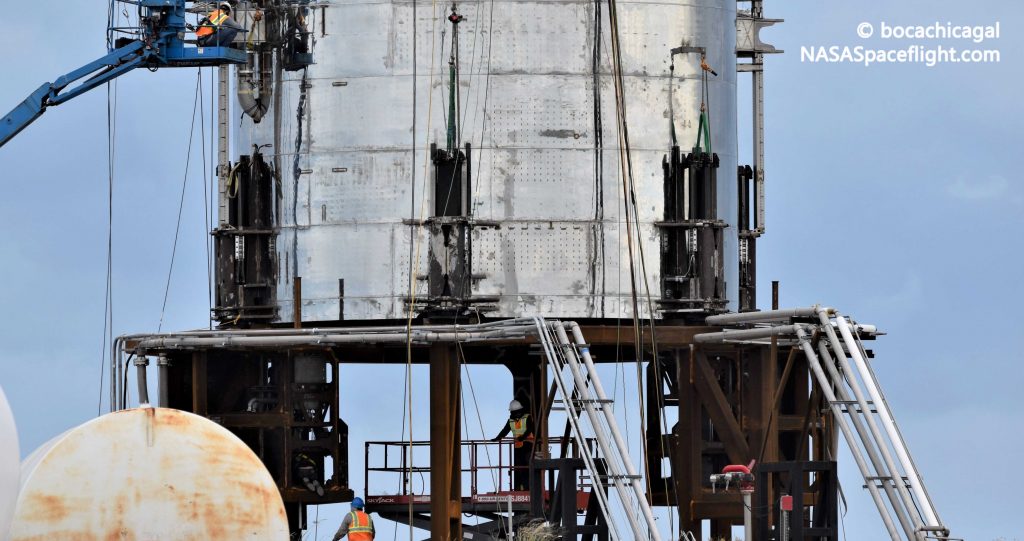
At SpaceX’s Boca Chica, Texas Starship facilities, the company has already made a huge amount of progress fabricating and outfitting a brand new launch mount that will soon support Starship Mk1’s first propellant loading, static fire, and flight tests. The spartan steel structure looks different from anything SpaceX has built in the past for Falcon 9 and is equally unrecognizable alongside the renders of a finished-product launch pad included in an updated Starship launch video.
What is undeniable, nevertheless, is the speed with which technicians have taken the Texas launch mount from a group of unconnected, partially-finished parts to a nearly complete structure with the business half of Starship Mk1 installed on top. SpaceX workers have built the mount, completed a large amount of plumbing to connect it to nearby liquid oxygen, methane, nitrogen, and helium reserves, and installed Starship on the mount in less than two months. The final integration of different prefabricated pieces began barely a month before Starship was moved to the pad, as pictured below.
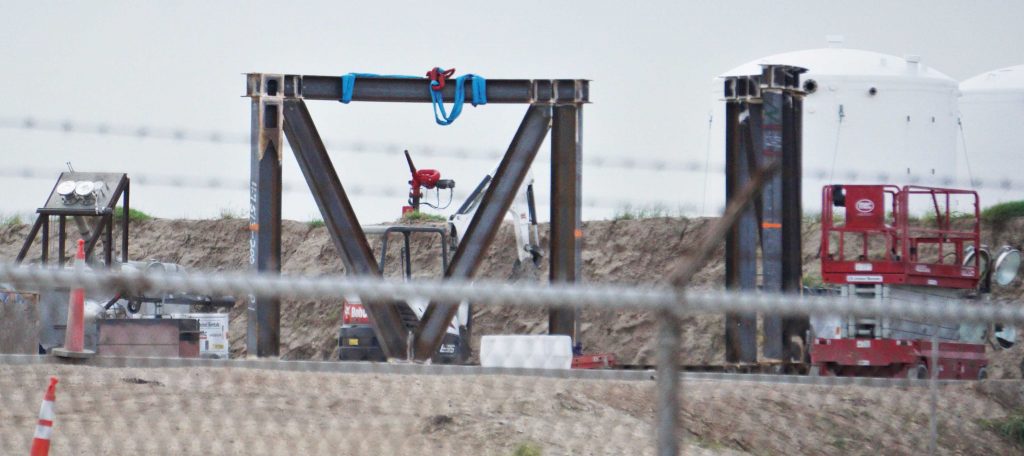
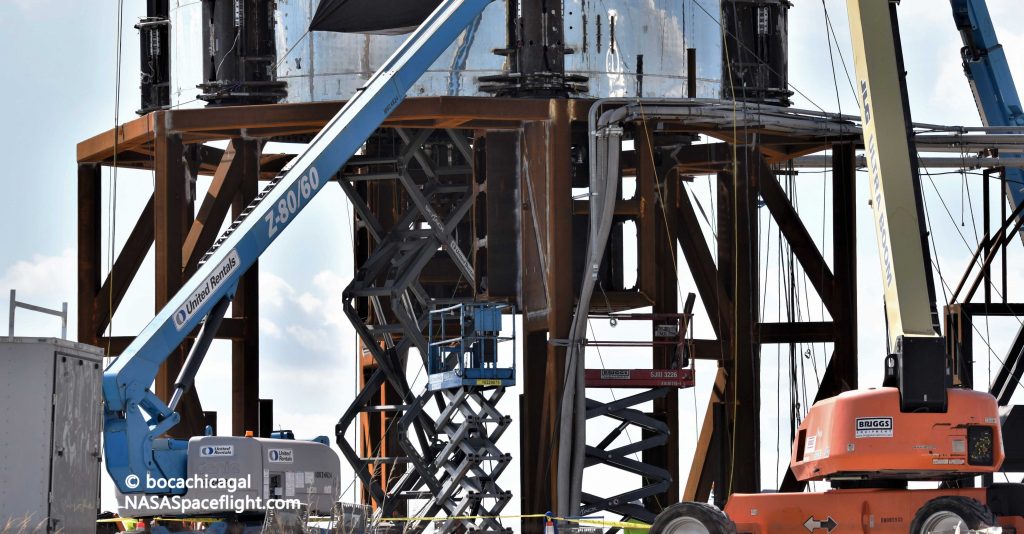
Two pads, two approaches
Although Boca Chica’s launch mount is quite large, based on Julia’s photos of Pad 39A, Florida’s nascent launch mount is going to be significantly bigger. The section that SpaceX began installing in the first days of November appears already be much taller than the mount in Texas, and it also looks more like a rectangular corner than anything resembling part of Boca Chica’s hexagonal structure.
At the same time, the apparent rectangular corner being worked on in Florida would be a much better fit for the partially-enclosed launch mount structure shown in SpaceX’s official 2019 Starship launch video.
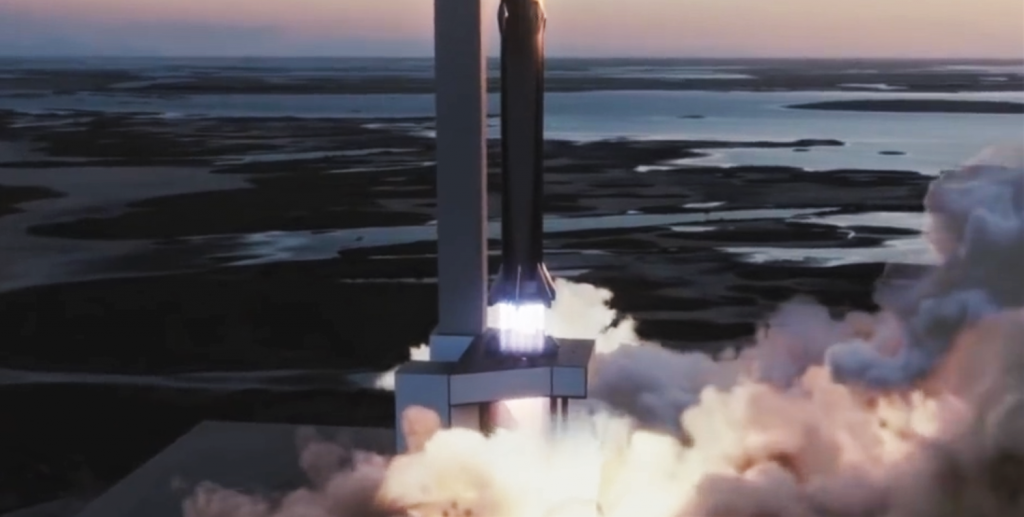
This is all to say that it looks like SpaceX is taking significantly different approaches with its two prospective Starship launch sites, which should come as no surprise in the context of the Starship program. SpaceX is already competitively building multiple Starship prototypes at two separate facilities in Boca Chica, Texas and Cocoa, Florida, a competition that has already produced visible differences between Mk1 and Mk2 prototypes. There’s a good chance that SpaceX intends to preserve that competitive atmosphere with Starship’s launch facilities, not just the rocket itself.
Additionally, it’s clear that Texas and Florida currently serve very different roles in the actual testing of Starship prototypes. Boca Chica has been active in that regard for more than half a year, ranging from the first Starhopper static fire in April to Starhopper’s 150-meter test flight in August. Florida has been almost entirely focused on iterating the build process itself and has already prefabricated nearly two dozen single-weld steel rings that will soon become Starship Mk4.
A step further, SpaceX CEO Elon Musk has made it clear that he is pushing for Starship’s first orbital launch to occur in the first half of 2020, an incredibly ambitious target given that the first Super Heavy booster prototype has yet to begin fabrication or assembly of any kind. Regardless, with that ambitious target in mind, SpaceX still needs to try to build a launch facility capable of standing up to a vehicle more powerful than Saturn V unfathomably quickly.
Head in the clouds
More likely than not, SpaceX’s Pad 39A Starship facilities will (attempt to) be that launch facility. An August 2019 environmental impact statement revealed that SpaceX would avoid Pad 39A’s massive flame trench and instead build a separate water-cooled thrust diverter, a technology SpaceX is extremely familiar with.
The diverter will likely have to be larger than anything SpaceX has ever attempted to build and will take a significant amount of time and money to fabricate, but the approach could potentially allow SpaceX to build Super Heavy-rated launch facilities from scratch in just 6-12 months. Put simply, however, SpaceX is not going to want to build a Starship-sized thrust diverter and launch mount in Florida if it will almost immediately have to build a second, larger replacement big enough for orbital launch attempts with Super Heavy.
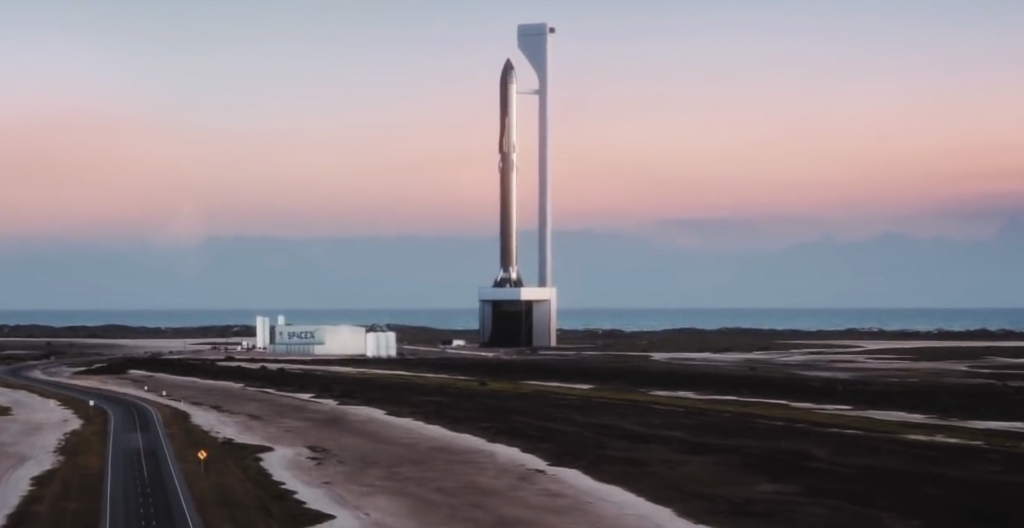
All things considered, it’s thus reasonably likely that SpaceX’s first draft of Florida Starship launch facilities will immediately jump to something sized for Super Heavy static fires and launches, even if that means it will take much longer to complete. If the pace of launch pad development in Boca Chica is anything to go by, it’s entirely possible that SpaceX will go from breaking ground at Pad 39A (mid-September 2019) to a more or less complete Starship-Super Heavy launch mount in roughly half a year.
Even if it takes more than a year to build, SpaceX could still be ready to attempt Starship’s first orbital launch well before the end of 2020.
Check out Teslarati’s Marketplace! We offer Tesla accessories, including for the Tesla Cybertruck and Tesla Model 3.

News
Tesla tinkering with Speed Profiles on FSD v14.2.1 has gone too far

Tesla recently released Full Self-Driving (FSD) v14.2.1, its latest version, but the tinkering with Speed Profiles has perhaps gone too far.
We try to keep it as real as possible with Full Self-Driving operation, and we are well aware that with the new versions, some things get better, but others get worse. It is all part of the process with FSD, and refinements are usually available within a week or so.
However, the latest v14.2.1 update has brought out some major complaints with Speed Profiles, at least on my end. It seems the adjustments have gone a tad too far, and there is a sizeable gap between Profiles that are next to one another.
Tesla FSD v14.2.1 first impressions:
✅ Smooth, stress-free highway operation
✅ Speed Profiles are refined — Hurry seems to be limited to 10 MPH over on highways. Switching from Mad Max to Hurry results in an abrupt braking pattern. Nothing of concern but do feel as if Speed…— TESLARATI (@Teslarati) November 29, 2025
The gap is so large that changing between them presents a bit of an unwelcome and drastic reduction in speed, which is perhaps a tad too fast for my liking. Additionally, Speed Profiles seem to have a set Speed Limit offset, which makes it less functional in live traffic situations.
Before I go any further, I’d like to remind everyone reading this that what I am about to write is purely my opinion; it is not right or wrong, or how everyone might feel. I am well aware that driving behaviors are widely subjective; what is acceptable to one might be unacceptable to another.
Speed Profiles are ‘Set’ to a Speed
From what I’ve experienced on v14.2.1, Tesla has chosen to go with somewhat of a preset max speed for each Speed Profile. With ‘Hurry,’ it appears to be 10 MPH over the speed limit, and it will not go even a single MPH faster than that. In a 55 MPH zone, it will only travel 65 MPH. Meanwhile, ‘Standard’ seems to be fixed at between 4-5 MPH over.
This is sort of a tough thing to have fixed, in my opinion. The speed at which the car travels should not be fixed; it should be more dependent on how traffic around it is traveling.
It almost seems as if the Speed Profile chosen should be more of a Behavior Profile. Standard should perform passes only to traffic that is slower than the traffic. If traffic is traveling at 75 MPH in a 65 MPH zone, the car should travel at 75 MPH. It should pass traffic that travels slower than this.
Hurry should be more willing to overtake cars, travel more than 10 MPH over the limit, and act as if someone is in a hurry to get somewhere, hence the name. Setting strict limits on how fast it will travel seems to be a real damper on its capabilities. It did much better in previous versions.
Some Speed Profiles are Too Distant from Others
This is specifically about Hurry and Mad Max, which are neighbors in the Speed Profiles menu. Hurry will only go 10 MPH over the limit, but Mad Max will travel similarly to traffic around it. I’ve seen some people say Mad Max is too slow, but I have not had that opinion when using it.
In a 55 MPH zone during Black Friday and Small Business Saturday, it is not unusual for traffic around me to travel in the low to mid-80s. Mad Max was very suitable for some traffic situations yesterday, especially as cars were traveling very fast. However, sometimes it required me to “gear down” into Hurry, especially as, at times, it would try to pass slower traffic in the right lane, a move I’m not super fond of.
We had some readers also mention this to us:
The abrupt speed reduction when switching to a slower speed profile is definitely an issue that should be improved upon.
— David Klem (@daklem) November 29, 2025
After switching from Mad Max to Hurry, there is a very abrupt drop in speed. It is not violent by any means, but it does shift your body forward, and it seems as if it is a tad drastic and could be refined further.
News
Tesla’s most affordable car is coming to the Netherlands
The trim is expected to launch at €36,990, making it the most affordable Model 3 the Dutch market has seen in years.
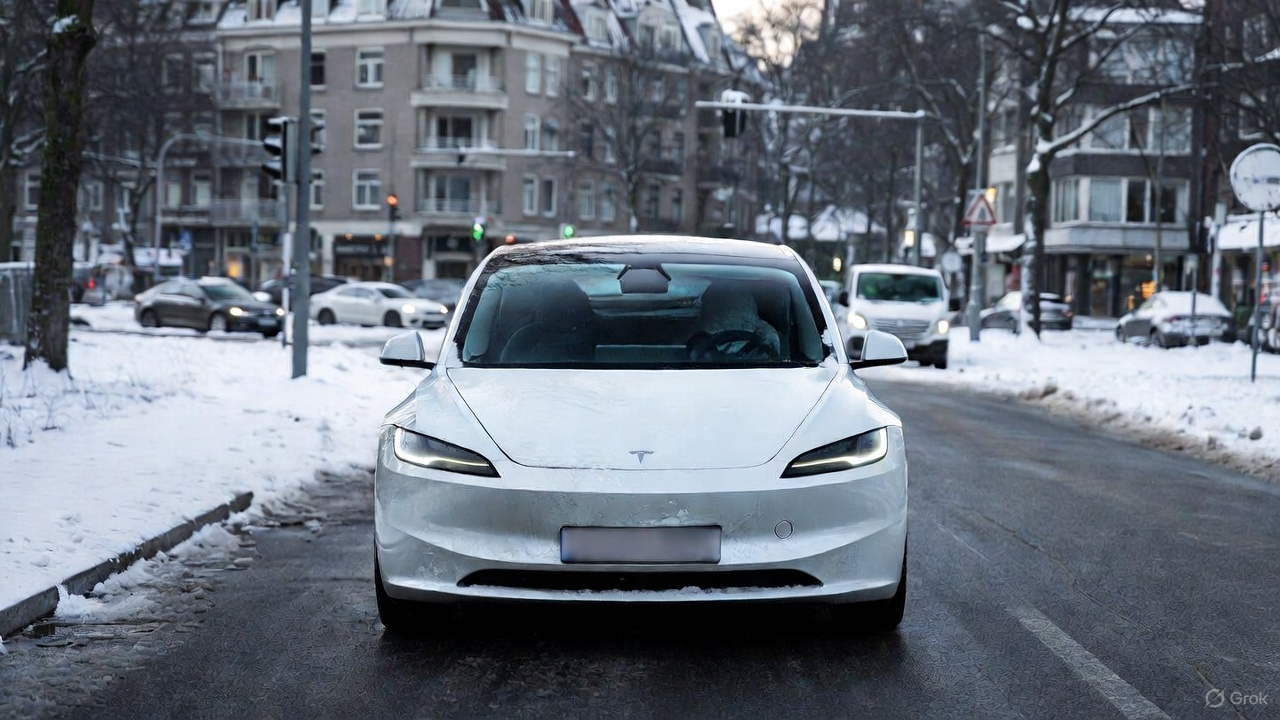
Tesla is preparing to introduce the Model 3 Standard to the Netherlands this December, as per information obtained by AutoWeek. The trim is expected to launch at €36,990, making it the most affordable Model 3 the Dutch market has seen in years.
While Tesla has not formally confirmed the vehicle’s arrival, pricing reportedly comes from a reliable source, the publication noted.
Model 3 Standard lands in NL
The U.S. version of the Model 3 Standard provides a clear preview of what Dutch buyers can expect, such as a no-frills configuration that maintains the recognizable Model 3 look without stripping the car down to a bare interior. The panoramic glass roof is still there, the exterior design is unchanged, and Tesla’s central touchscreen-driven cabin layout stays intact.
Cost reductions come from targeted equipment cuts. The American variant uses fewer speakers, lacks ventilated front seats and heated rear seats, and swaps premium materials for cloth and textile-heavy surfaces. Performance is modest compared with the Premium models, with a 0–100 km/h sprint of about six seconds and an estimated WLTP range near 550 kilometers.
Despite the smaller battery and simpler suspension, the Standard maintains the long-distance capability drivers have come to expect in a Tesla.
Pricing strategy aligns with Dutch EV demand and taxation shifts
At €36,990, the Model 3 Standard fits neatly into Tesla’s ongoing lineup reshuffle. The current Model 3 RWD has crept toward €42,000, creating space for a more competitive entry-level option, and positioning the new Model 3 Standard comfortably below the €39,990 Model Y Standard.
The timing aligns with rising Dutch demand for affordable EVs as subsidies like SEPP fade and tax advantages for electric cars continue to wind down, EVUpdate noted. Buyers seeking a no-frills EV with solid range are then likely to see the new trim as a compelling alternative.
With the U.S. variant long established and the Model Y Standard already available in the Netherlands, the appearance of an entry-level Model 3 in the Dutch configurator seems like a logical next step.
News
Tesla Model Y is still China’s best-selling premium EV through October
The premium-priced SUV outpaced rivals despite a competitive field, while the Model 3 also secured an impressive position.

The Tesla Model Y led China’s top-selling pure electric vehicles in the 200,000–300,000 RMB segment through October 2025, as per Yiche data compiled from China Passenger Car Association (CPCA) figures.
The premium-priced SUV outpaced rivals despite a competitive field, while the Model 3 also secured an impressive position.
The Model Y is still unrivaled
The Model Y’s dominance shines in Yiche’s October report, topping the chart for vehicles priced between 200,000 and 300,000 RMB. With 312,331 units retailed from January through October, the all-electric crossover was China’s best-selling EV in the 200,000–300,000 RMB segment.
The Xiaomi SU7 is a strong challenger at No. 2 with 234,521 units, followed by the Tesla Model 3, which achieved 146,379 retail sales through October. The Model Y’s potentially biggest rival, the Xiaomi YU7, is currently at No. 4 with 80,855 retail units sold.
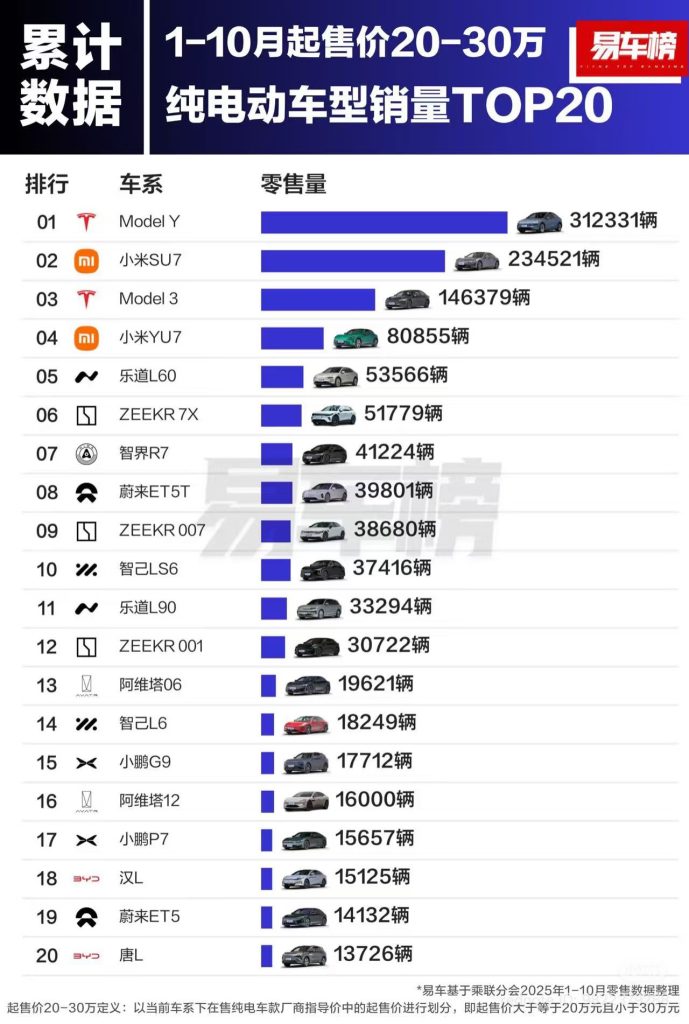

Efficiency kings
The Model 3 and Model Y recently claimed the top two spots in Autohome’s latest real-world energy-consumption test, outperforming a broad field of Chinese-market EVs under identical 120 km/h cruising conditions with 375 kg payload and fixed 24 °C cabin temperature. The Model 3 achieved 20.8 kWh/100 km while the Model Y recorded 21.8 kWh/100 km, reaffirming Tesla’s efficiency lead.
The results drew immediate attention from Xiaomi CEO Lei Jun, who publicly recognized Tesla’s advantage while pledging continued refinement for his brand’s lineup.
“The Xiaomi SU7’s energy consumption performance is also very good; you can take a closer look. The fact that its test results are weaker than Tesla’s is partly due to objective reasons: the Xiaomi SU7 is a C-segment car, larger and with higher specifications, making it heavier and naturally increasing energy consumption. Of course, we will continue to learn from Tesla and further optimize its energy consumption performance!” Lei Jun wrote in a post on Weibo.









